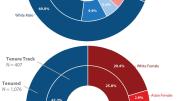A decade ago, more than two-thirds of tenured professors and nearly one-half of tenure-track professors at Harvard were white men. Since then, the composition of the faculty has evolved considerably, most notably among tenured professors: 25.8 percent are women and 18.8 percent are minorities, up from 20.5 percent and 12.6 percent in 2008. The share of tenured underrepresented minorities, including African Americans and Latinos (Harvard has no Native American professors), increased to 7.7 percent from 5 percent in the same period.
If these changes sound small, that is because faculty turnover is slow. Harvard has added 49 tenure-track and 42 tenured faculty members this year, within a total body of just under 1,500. “With the faculty not changing in size, and very few retirements, this actually reflects a real push on the part of the leadership of the University,” says senior vice provost Judith Singer, who directs the office of faculty development and diversity. Harvard’s schools hire one faculty member at a time, and recruitment is a very intensive activity. Of tenure-track and tenured appointees made in 2015-2016, 19 percent are minority men, 16 percent minority women, 22 percent white women, and 43 percent white men.
Diversity still varies widely at the departmental level. “The [Faculty of Arts and Sciences] divisions that are doing particularly well are, not surprisingly, the places where the graduate-student pools are themselves more diverse,” Singer says. The arts and humanities division has the University’s largest fraction of tenure-track women: 63 percent. The schools of education and divinity have relatively high shares of underrepresented minority faculty members, reflecting the makeup of Ph.D. programs in those fields. Singer also gives credit to high achievers in fields that typically aren’t as diverse. Women represent 46 percent of tenure-track faculty in FAS’s science division, for example: “That is really high.” In the school of engineering and applied sciences, underrepresented minorities now make up 15 percent of tenure-track faculty.
Additional details are available at harvardmag.com/facdiversity-17.









